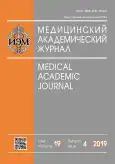Вовлечение HIF-1α и эритропоэтина в антидепрессивный эффект гипоксического посткондиционирования в модели выученной беспомощности у крыс
- Авторы: Зенько М.Ю.1, Рыбникова Е.А.1
-
Учреждения:
- Институт физиологии им. И.П. Павлова РАН
- Выпуск: Том 19, № 4 (2019)
- Страницы: 41-46
- Раздел: Оригинальные исследования
- Статья опубликована: 03.04.2020
- URL: https://journals.eco-vector.com/MAJ/article/view/19075
- DOI: https://doi.org/10.17816/MAJ19075
- ID: 19075
Цитировать
Полный текст
Аннотация
Цель исследования — оценить роль HIF-1α в антидепрессивных эффектах гипоксического посткондиционирования в экспериментальной модели депрессии «выученная беспомощность» у крыс.
Материалы и методы. Исследования проведены в модели депрессивноподобного расстройства «выученная беспомощность» на крысах. Развитие патологии оценивали в поведенческом тесте «открытое поле», а также по базальному уровню кортикостерона в плазме крови крыс. Поведенческие нарушения корректировали путем применения трехкратного гипоксического посткондиционирования (360 мм рт. ст., 2 ч). Изменение иммунопозитивности HIF-1α и эритропоэтина в гиппокампе крыс исследовали количественным иммуногистохимическим методом. Ингибитор трансляции HIF-1α топотекан (1 мг/кг, внутрибрюшинно, Santa Cruz, США) вводили на 4-й день после стресса, депрессивноподобное поведение крыс оценивали на 9-й постстрессорный день.
Результаты. Показано, что посткондиционирование, осуществленное за три сеанса умеренной гипобарической гипоксии, приводило к коррекции поведенческого дефицита и уровня кортикостерона в крови у крыс в данной модели, что сопровождалось повышением количества HIF-1α и эритропоэтина в дорзальном и вентральном гиппокампе. Введение ингибитора HIF-1α крысам усиливало поведенческие проявления «выученной беспомощности» в тесте «открытое поле».
Заключение. Представлены экспериментальные данные, свидетельствующие о вероятном вовлечении HIF-1 и эритропоэтина в эндогенные процессы компенсации патогенного действия стрессоров психоэмоциональной природы и антидепрессивные эффекты гипоксического посткондиционирования.
Полный текст
Об авторах
Михаил Юрьевич Зенько
Институт физиологии им. И.П. Павлова РАН
Автор, ответственный за переписку.
Email: ZenkoMY@infran.ru
ORCID iD: 0000-0002-9868-0598
SPIN-код: 6632-3116
младший научный сотрудник
Россия, Санкт-ПетербургЕлена Александровна Рыбникова
Институт физиологии им. И.П. Павлова РАН
Email: RybnikovaEA@infran.ru
ORCID iD: 0000-0002-8956-726X
SPIN-код: 9663-4704
д-р биол. наук, заведующий лабораторией, заместитель директора
Россия, Санкт-ПетербургСписок литературы
- Samoilov MO, Rybnikova EA, Tulkova EI, et al. Hypobaric hypoxia affects rat behavior and immediate early gene expression in the brain: the corrective effect of preconditioning. Dokl Biol Sci. 2001;381:513-515. https://doi.org/10.1023/a:1013301816108.
- Patent RUS No. 2437164/ 20.12.2011. Rybnikova EA, Samoilov MO. Sposob reabilitatsii posle gipoksii, vyzyvayushchey narusheniya funktsiy mozga v modelyakh na laboratornykh zhivotnykh.
- Rybnikova E, Vorobyev M, Pivina S, Samoilov M. Postconditioning by mild hypoxic exposures reduces rat brain injury caused by severe hypoxia. Neurosci Lett. 2012;513(1):100-105. https://doi.org/10.1016/j.neulet.2012.02.019.
- Gamdzyk M, Makarewicz D, Slomka M, et al. Hypobaric hypoxia postconditioning reduces brain damage and improves antioxidative defense in the model of birth asphyxia in 7-day-old rats. Neurochem Res. 2014;39(1):68-75. https://doi.org/10.1007/s11064-013-1191-0.
- Vetrovoi OV, Rybnikova EA, Glushchenko TS, Samoilov MO. Effects of hypoxic postconditioning on the expression of antiapoptotic protein Bcl-2 and neurotrophin BDNF in hippocampal field CA1 in rats subjected to severe hypoxia. Neurosci Behav Physiol. 2015;45(4):367-370. https://doi.org/10.1007/s11055-015-0083-y
- Vetrovoy OV, Rybnikova EA, Glushchenko TS, et al. Mild hypobaric hypoxic postconditioning increases the expression of HIF-1α and erythropoietin in the CA1 field of the hippocampus of rats that survive after severe hypoxia. Neurochem J. 2014;8(2):103-108. https://doi.org/10.1134/s1819712414020123.
- Sarieva KV, Lyanguzov AY, Galkina OV, Vetrovoy OV. The effect of severe hypoxia on HIF1- and Nrf2-Mediated mechanisms of antioxidant defense in the rat neocortex. Neurochem J. 2019;13(2):145-155. https://doi.org/10.1134/s1819712419020107.
- Kodama T, Shimizu N, Yoshikawa N, et al. Role of the glucocorticoid receptor for regulation of hypoxia-dependent gene expression. J Biol Chem. 2003;278(35):33384-33391. https://doi.org/10.1074/jbc.M302581200.
- Jelkmann W. Molecular Biology of Erythropoietin. Intern Med. 2004;43(8):649-659. https://doi.org/10.2169/internalmedicine.43.649
- Marti HH. Erythropoietin and the hypoxic brain. J Exp Biol. 2004;207(18):3233-3242. https://doi.org/10.1242/jeb.01049.
- Paschos N, Lykissas MG, Beris AE. The role of erythropoietin as an inhibitor of tissue ischemia. Int J Biol Sci. 2008;4(3):161-168. https://doi.org/10.7150/ijbs.4.161.
- Tringali G, Pozzoli G, Lisi L, Navarra P. Erythropoietin inhibits basal and stimulated corticotropin-releasing hormone release from the rat hypothalamus via a nontranscriptional mechanism. Endocrinology. 2007;148(10):4711-4715. https://doi.org/10.1210/en.2007-0431.
- Seligman ME, Beagley G. Learned helplessness in the rat. J Comp Physiol Psychol. 1975;88(2):534-541. https://doi.org/10.1037/h0076430.
- Rybnikova E, Mironova V, Pivina S, et al. Involvement of the hypothalamic-pituitary-adrenal axis in the antidepressant-like effects of mild hypoxic preconditioning in rats. Psychoneuroendocrinology. 2007;32(7):813-823. https://doi.org/10.1016/j.psyneuen.2007.05.010.
- Hall CS. Emotional behavior in the rat. III. The relationship between emotionality and ambulatory activity. J Comp Psychol. 1936;22(3):345-352. https://doi.org/10.1037/h0059253.
- Kaelin WG, Ratcliffe PJ. Oxygen sensing by metazoans: the central role of the HIF hydroxylase pathway. Mol Cell. 2008;30(4):393-402. https://doi.org/10.1016/j.molcel.2008. 04.009.
- Agani F, Jiang B-H. Oxygen-independent regulation of HIF-1: novel involvement of PI3K/ AKT/mTOR pathway in cancer. Curr Cancer Drug Targets. 2013;13(3):245-251. https://doi.org/10.2174/1568009611313030003.
- O’Rourke JF, Tian Y-M, Ratcliffe PJ, Pugh CW. Oxygen-regulated and transactivating domains in endothelial PAS Protein 1: comparison with hypoxia-inducible factor-1α. J Biol Chem. 1999;274(4):2060-2071. https://doi.org/10.1074/jbc.274.4.2060.
- Masson N, Willam C, Maxwell PH, et al. Independent function of two destruction domains in hypoxia-inducible factor-alpha chains activated by prolyl hydroxylation. EMBO J. 2001;20(18):5197-5206. https://doi.org/10.1093/emboj/ 20.18.5197.
- Jegalian AG, Wu H. Differential roles of SOCS family members in EpoR signal transduction. J Interferon Cytokine Res. 2002;22(8):853-860. https://doi.org/10.1089/ 107999002760274863.
- Risau W. Mechanisms of angiogenesis. Nature. 1997;386(6626):671-674. https://doi.org/10.1038/386671a0.
- Rybnikova EA, Baranova KA, Gluschenko TS, et al. Role of HIF-1 in neuronal mechanisms of adaptation to psychoemotional and hypoxic stress. International Journal of Physiology and Pathophysiology. 2015;6(1):1-11. https://doi.org/10.1615/IntJPhysPathophys.v6.i1.10.
- Baranova KA, Rybnikova EA, Samoilov MO. The dynamics of HIF-1α expression in the rat brain at different stages of experimental posttraumatic stress disorder and its correction with moderate hypoxia. Neurochemical Journal. 2017;11(2): 149-156. https://doi.org/10.1134/s1819712417020027.
- Lee HY, Gao X, Barrasa MI, et al. PPAR-alpha and glucocorticoid receptor synergize to promote erythroid progenitor self-renewal. Nature. 2015;522(7557):474-477. https://doi.org/10.1038/nature14326.
Дополнительные файлы










